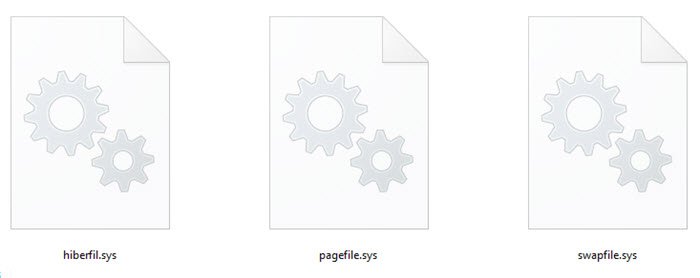Hiberfil.sys, Pagefile.sys & the New Swapfile.sys file - Windows 11/10
The Windows operating system contains several organization files required for its proper functioning. Some of them which raise a lot of curiosity are Swapfile.sys, Hiberfil.sys & Pagefile.sys. To see these system files on your Organisation (C) Drive root, yous will have to united nations-hide protected operating organisation files from Folder Options. In this mail service, we will briefly talk well-nigh each file.

What is Hiberfil.sys file
Hiberfil.sys file is a organization file that is used by Windows to support Hibernation. If you lot have enabled Hibernation in Windows 10, you lot volition see this file.
When you take Hibernation, and later on Fast Startup enabled (which is the default setting), your Hiberfil.sys file will be approximately three/4th of your RAM in Windows 7.
In Windows 11/10 now, it is twoscore%. In case you have disabled Hibernation, you will observe its size roughly equalling your RAM. In Windows 11/x/8, y'all will not notice the size of Hyberfil.sys running wild when you have Hibernation enabled. In the before version of Windows, the hibernation file stored the kernel session, device drivers, and application data. In Windows 11/10, the hibernation file stores the kernel session and device drivers only, as a result of which the size remains more or less constant.
Disable Hibernation
If you wish to, yous can always disable/enable hibernation manually or by using our Ultimate Windows Tweaker, or a Microsoft Fix It. But and so remember, that in Windows 10/eight, this will disable Fast Startup too. If you feel the demand to, you can modify the size of hiberfil.sys file.
What is Pagefile.sys file
Pagefile.sys or the Page File is the calculator paging file that your Windows uses as Virtual memory. PageFile.sys holds objects in an over-used memory that has not been accessed for a long period of time. When Windows runs out of concrete memory, it resorts to using the Page File, by writing some of the contents of RAM on to the deejay. If this 'Paged out' retention is needed dorsum, some other part is written to disk, and this part is read back.
If yous frequently get a message Your system is low on virtual retentiveness, when you try to start whatever memory-intensive application, you may want to increase the Paging File size.
Read: How to Back up or Move PageFile.sys.
Delete Pagefile.sys
Immigration the Page file on every shutdown ways overwriting the information past zeros, and it takes time. This volition increase the shutdown fourth dimension. But if you work on confidential documents, then you may want to take this setting 'on'. When you load such documents, they are loaded into RAM. To save RAM Windows places certain items on the pagefile. Hence you lot may want to delete pagefile at every shutdown, in such cases. To do so open up Regedit and navigate to the following central:
HKEY_LOCAL_MACHINE\SYSTEM\CurrentControlSet\Control\Session Manager\Retentivity Management
In the right pane, select New > DWORD (32-fleck) Value. Name the DWORD value ClearPageFileAtShutdown and give it a value of 1.
Read: What is the best Page File size for 64-fleck versions of Windows?
What is Swapfile.sys file
In before versions of Windows, you had Swapfile.sys or the Swap file. The Swap file holds objects which take been ejected from memory and are not expected to be accessed for some time and allow an operating system to use hard deejay space to simulate actress memory whenever the system runs low on memory, by swapping section of RAM that an idle program is using onto the hd to gratis upwards memory for other programs. This combination of RAM and Swap files is known equally Virtual Retention. Having a swap file makes your computer'due south operating organisation "have" more RAM than it actually has.
The Swapfile is not used in the fast startup process of Windows 11/10. It is the Hiberfil.sys file which stores the kernel session and comes into play here.
In Windows 11/10, you once again become to see Swapfile.sys! This latest version of Windows has both – the swapping besides equally the paging file at the same time. It is around 256 MB in size – in my instance, it is 262 MB.
Why do we need another virtual folio file in Windows xi/10?
The Swapfile.sys in Windows eleven/x is a special blazon of pagefile used internally past the system to make sure types of paging operations more than efficient. It is used to Suspend or Resume UWP Windows apps.
TechNet explains the 'new' Swapfile.sys in Windows as follows:
With the introduction of the UWP App, nosotros needed a style to manage their retentiveness outside of the traditional Virtual Memory/Pagefile method. With that, the "%SystemDrive%\swapfile.sys" was born.
Windows tin can efficiently write the whole (private) working set of a suspended UWP app to disk in order to gain boosted memory when the organisation detects pressure. This process is analogous to hibernating a specific app, and then resuming it when the user switches back to the app. In this example, Windows takes advantage of the append/resume mechanism of Modern apps to empty or re-populate an app's working fix.
I hope this explains the reason why we see all the three files viz. Hiberfil.sys, Pagefile.sys & Swapfile.sys files in Windows 11/10.
Looking to learn more most other files or file types or file formats in Windows? Check these links:
Windows.edb files | Thumbs.db files | DLL and OCX files | Desktop.ini file | Nvxdsync.exe.

Source: https://www.thewindowsclub.com/hiberfil-pagefile-swapfile-sys-windows
Posted by: wileylicep1943.blogspot.com


0 Response to "Hiberfil.sys, Pagefile.sys & the New Swapfile.sys file - Windows 11/10"
Post a Comment